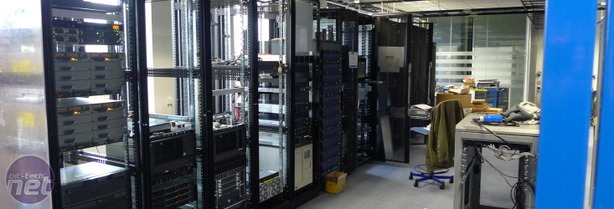Test setup
Due to the wide ranging demands of different software we’ve designed a comprehensive suite of professional application benchmarks, backed by a small number of synthetic tests for this review.These range from 3D animation and rendering packages to real-world HPC (high-performance computing) simulations that are usually run on mammoth clusters.
Professional applications
Here is a list of the professional applications we used for our testing:- Cinebench R10
- Cinebench R11
- Euler 3D
- FlamMap
- LightWave 9.6
- Terragen 2
- Protein folding with Folding@home
Synthetic tests
Here is a list of the synthetic test applications we used for our testing:- WPrime
- Prime95
- Stream

Intel's server test lab in its UK office where we carried out testing. Click to enlarge.
Because we were unable to carry out the testing in the bit-tech lab we were forced to use whatever hardware Intel had to hand. This comprised a demo system built around the Intel demo motherboard shown earlier with four 2.26GHz Xeon X7560s, the flagship model of the Xeon 7500-series. As each CPU has it's own quad-channel memory controller, so give the optimum performance Xeon 7500-series should have DIMMs installed in multiplies of 16. For this reason Intel had pre-fitted the system with 16 8GB 1,066MHz ECC registered DDR3 Crucial DIMMs.
You might think this would give the Xeon 7500-system a massive advantage over the systems we're comparing it to, but none of the benchmarks we use address more than 8GB of RAM apart from Folding@home. Even then, this test only needs more RAM than this because the Xeon 7500-system has so many execution units (64).
Althought the recently launched Opteron 6000-series does support up to eight CPUs in one system, there aren't any four or eight socket motherboards available right now. As a result, we can only compare the quadruple of Xeon X7560s against a system with a pair of Opteron 6174s. The only exception to this is the Folding@home benchmark, which have we run on a system with four Xeon X7460s in the past. These are the fastest models of the previous generation of the Xeon 7400-series, what the Xeon 7500-series is intended to replace.
We've also included the benchmark results of a variety of other dual-processor systems, just to show what sort of performance scaling a second pair of CPUs may bring to your applications. Unfortunately we didn't have all of these systems to hand anymore, so there are some gaps in a few of the graphs. Still, it's useful to see how much additional performance these new CPUs offer over their predecesors. Even though a single-processor system does not offer the same relability/manageability of a quad-processor workstation/server - at readers' request we've also included some benchmark results from a Core i7-930 and Core-i7 980X Extreme Edition.
The Opteron 6174s were tested in a Supermicro H8DGU-F motherboard while the Xeon X5650s were benchmarked in a Supermicro X8DTU-F motherboard. Both were installed in a Supermicro 1U rack mount chassis equipped with the same 650W PSU and Western Digital hard disk.
The older systems comprised a pair of LGA1366 Xeon W5580 in a Supermicro X8DA3-O motherboard. Also included are some benchmark results from a pair of LGA771 Xeon X5482 CPUs and a pair of LGA771 Core 2 Extreme QX9775s in an Intel D5400XS Skulltrail motherboard. Finally, you'll also see some benchmark results from a pair of Opteron 2435 in a Supermicro H8DAE-2 motherboard and a pair of Opteron 2383s and in a Supermicro H8DA8-2 motherboard. The two Core i7 processors were benchmarked on an Asus P6TD Deluxe.
Test Setup
- Operating System: Microsoft Windows Server 2008 R2
- Operating System: Oracle Red Hat Enterprise 5.4
- Hard Drive: Western Digital 1TB RE3 WD1002FBYS
- Memory: Crucial 1,066MHz registered ECC DDR3

MSI MPG Velox 100R Chassis Review
October 14 2021 | 15:04









Want to comment? Please log in.